Tauba Auerbach at Bergen Kunsthall (? 2011)

visualizing the understanding of relationships
research blog supporting instantdebriefing.com
In the trailer of the upcoming Tegenlicht-episode, Noreena Hertz says:
If you owe the bank € 1000, it is your problem.
If you owe a bank 1,000,000 Euros it is their problem.
…suggesting a transition point/phase of Loyalty.
In an earlier post I commented on the work of Poiesz. Adopting this methodology leads to the following mental exercise.
According to Poiesz, an individual has intrinsic and extrinsic Motivation, Abbitity and Opportunity that defines behavior. These elements have to be taken into account of one another. Together they mark a behavioral factor: M*O*A = behavioral score.
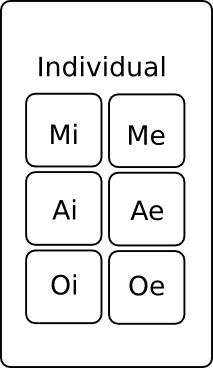
The Intrinsic and Extrinsic Motivation (Mi, Me) together define the overall Motivation. However, there is the possibility that when the internal motivation is firm, it can over rule the external motivation (‘social pressure’, page 65, Gedragsmanagement, Poiesz 1999). Vice versa is assumable as well (frustration). The impact of M is as follows.
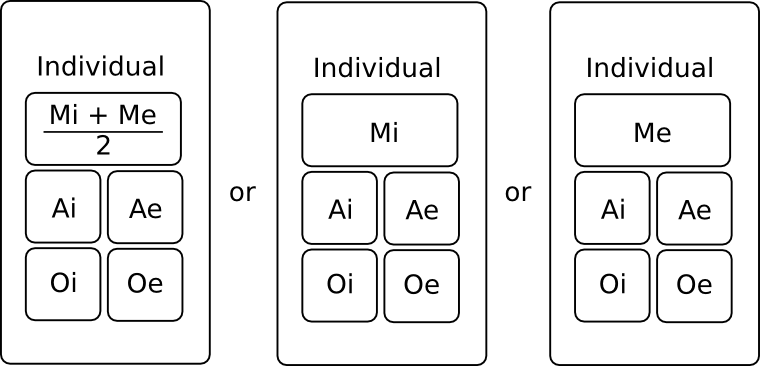
Let us assume the individual working in a team with a manager within an organisation.
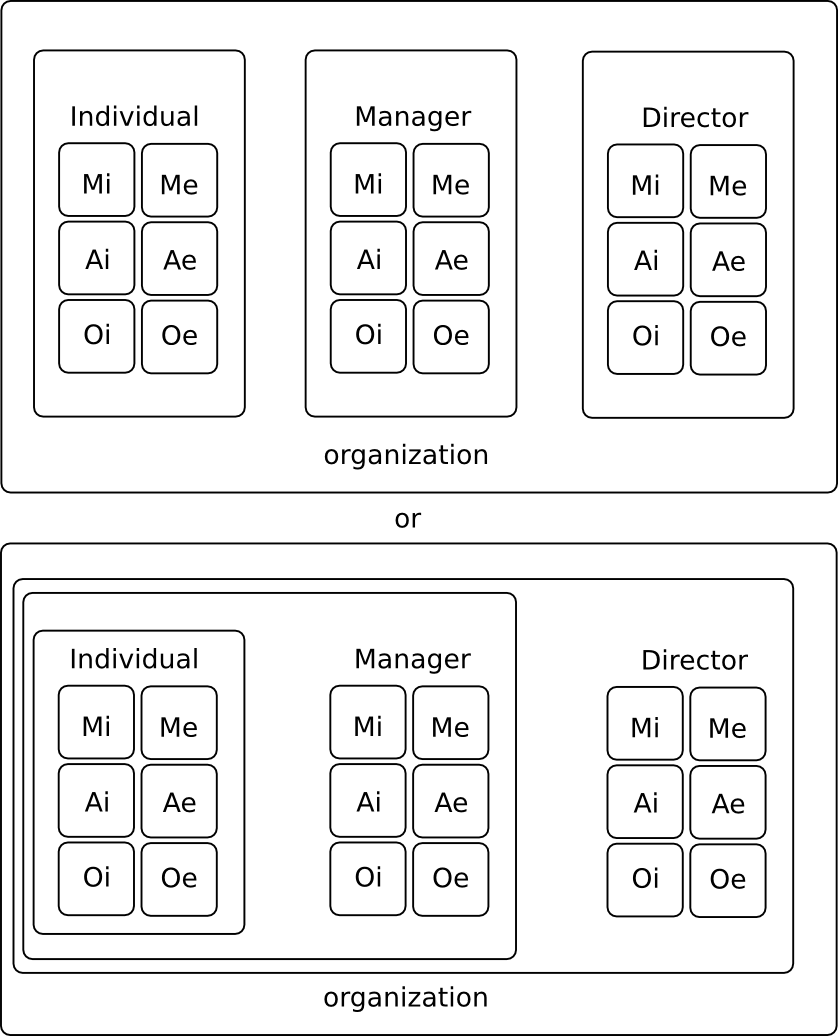
Let us now propose that the internal factors (Mi*Ai*Oi) are more or less stable and that the external factors are influenced by the persons up the hierarchical ladder. For instance the manager offers a personal appreciation (Ind +Me), a training budget (Ind +Ae) and agrees with the individuals personal development plan (Ind +Oe). In parallel, the director delivers a motivational management speech (Man +Me), additional secretarial support (Man +Ae) and plans for market diversification (Man +Oe).
Of course, external conditions influence all persons as well (check DESTEP: i.e. competitors, market developments, pension, bonus system, tax rules, climate change, transport).
Zooming in on the individual and the manager, we see an interaction. The individual’s total behavior has an impact on the extrinsic behavior of the manager and likewise the manager’s total behavior has an impact on the extrinsic behavior of the individual:
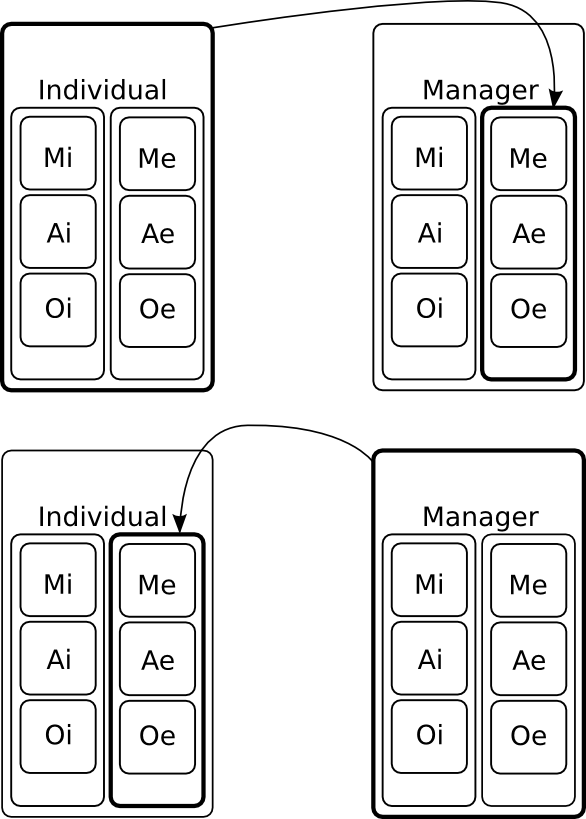
The same goes for the behavioral impact between manager and director. Accordingly, the same goes for individuals that represent organisations within an alliance. See an example of 5 partnering organizations, with individual representatives (only 2 interactions drawn):
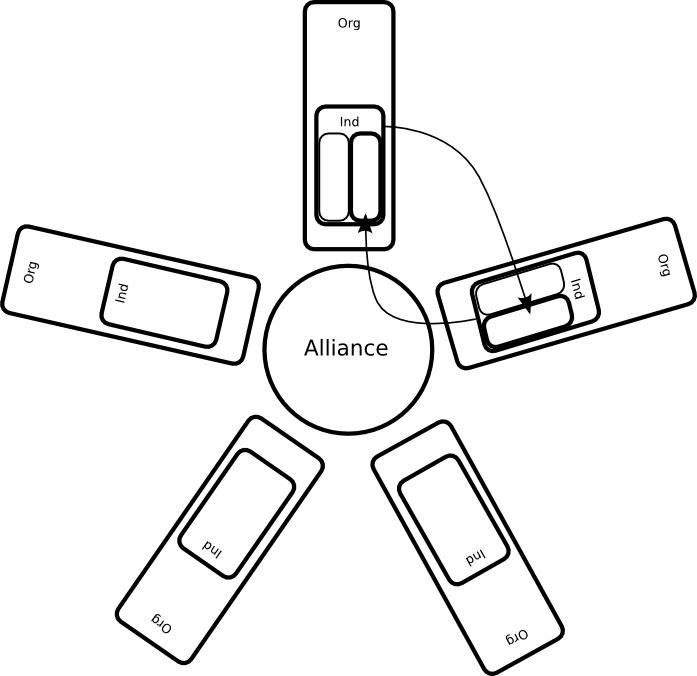
This exercise suggests that a persons behavior impacts the extrinsic motivation (Me, Ae, Oe) of both collegues and partners. There is a chain (or actually an interwoven network) of feedback loops of the wholes of the behavior onto parts of the behavior.
For now we see:
Note about factorization: this concerns driving new behavior or qualitative steering of existing behavior
Note about influence: the same goes for B ont A, and for all other individuals
A similar exercise using the Aizen model (or Leary’s Rose) would offer interesting material for comparization. Besides real world measurements and data assimilation.
As Processing coder & Arduino embedder & (recently) HTC user, this 2010 documentary makes me happy… 130.000 sold Arduino’s in 2010!
The 2001 book ‘Where the action is’ by Paul Dourish is coming to life. What if we would use an Arduino to introduce physically embedded ‘loyalty-sliders’ into multi actor, distributed power meetings?
Imagine a sketch like this, connected to physical sensors & actors in a decision making environment:
Suddenly alliance representatives are able to mark and distribute 100% sensed loyalties, igniting a discussion that matters: a discussion about individual, internal and external interests and loyalties
… and instead of using visual sliders, we could automate as well, according to http://frontiernerds.com/brain-hack

This blog post is a visual reflection of the current proposal, and works towards an overall typology of interorganizational dynamics.
Let us asume 5 ambitious persons, whose interests have a focus of technology, business and biology.
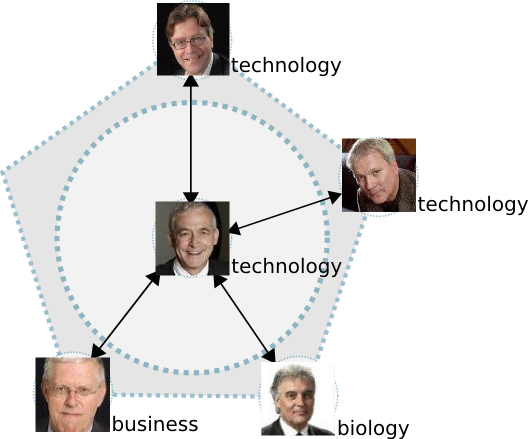
Suppose these persons are in fact Rectores Magnifici of (some of) the leading Universities in the Netherlands.
As described in Examples, the Delft University of Technology (DUT) building / consolidating on both a regional & cross domain level and a national & technological orriented level.

Let us asume there is a set of cooperations, visualized from the DUT perspective.
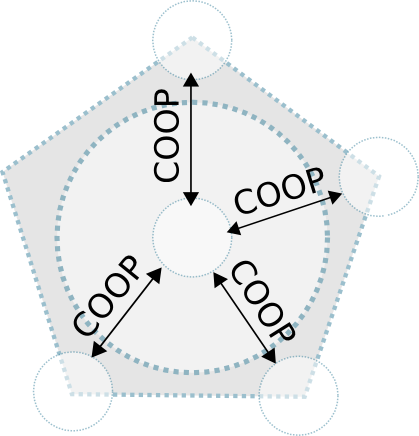
Beacuse of cooperation, there is competition as well. Running parallel paths (national + technological & regional + cross domain) can be an energy drain for an organization, as well as a mechanism to ensure robustness of the strategy.
It is unclear whether or not a strong regional alliance has a positive or negative effect on the 3TU-activities. And vise versa.
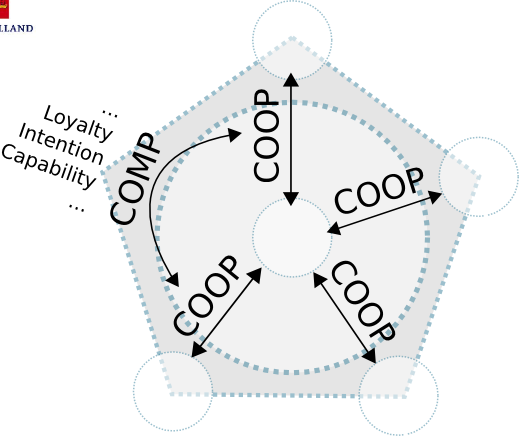
It is always good to try and split double headed arrows. As a result we find two types of interests: convergence and divergence. We can identify two supra local (above local) interests, both converging in on the DUT.
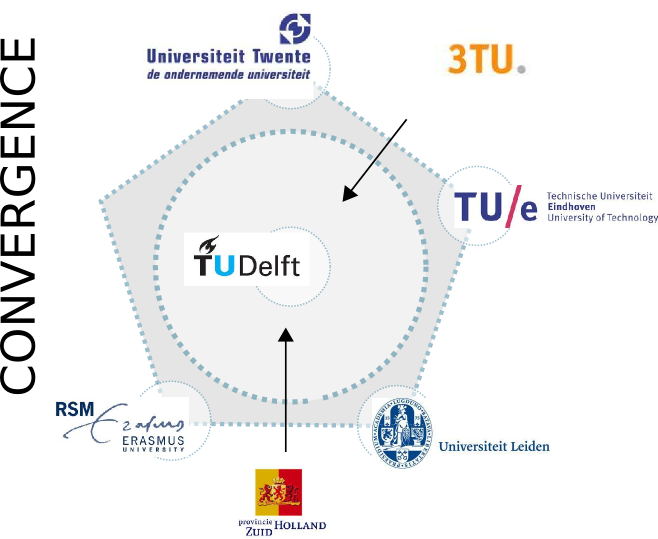
We can also identify four ‘cross local’ divergent activities: the DUT is connecting towards other local initiatives.
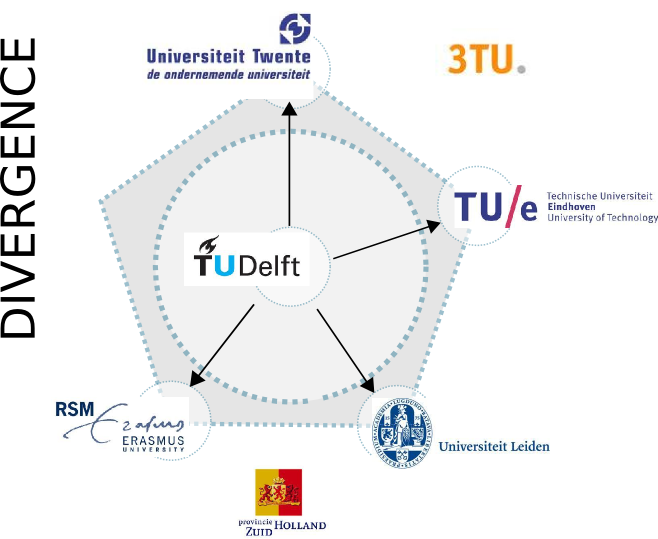
This example is from the DUT perspective. The local activities as well as the supra local activities in fact are all two way streets. The traffic does not have to meet in the middle and the reach of approaching traffic has an effect on the outgoing traffic. There is a delicate balance of loyaties, intentions and interests.
Within a complex context, people and organizations discover new processes. This is contradicting to complicated context, where a blue print or screen play can be created up front to guide individuals and organizations. During complicated situations a protective role of judical departments is more helpfull, whereas during complex situations an enabling role of objective advisers is better at hand.
This research aims at enlightening a multi actor, inter organizational context in which organizations have to deal with the lack of a single effective command. Such a context demands developing other capabilities of employees and offering a different support to those employees. Strengthening the effectiveness of decision making calls for an unambiguous get-the-pulse system, let alone because of the fact that today numuruous organizations are all at the same time inventing alliance dynamics.
There lies a common ground, a shared but hidden typology of dynamics: these dynamics deal with differentiation over time, place and reach, together with converging and diverging actions, interests, responsibilities, loyalties and intentions of both individuals and organizations.
Today I visited the third Hippo Campus Lecture, provided by Kembo. Guest of honour: Prof. Gerald Hüther, neurobiologist and brain scientist.
Hüther focused his presentation on “Haltung/ innere uberzeugung/ innere Einstellung”. Like Aizen (see posts about planned behavior, approaches to attitude formation & multi agent and culture) he argues that behavioral change starts not with attitude, but beliefs, or a mindset as he calls it. He spoke about “Erfahrungen unter den Haut”, when “das cognitieve Anteil und das emotionelle Anteil vereinigt zusammen arbeiten”: “wenn man emotional nichts tut, andert sich auch nichts”.
He rejected a definite impact of emotional strategies, like rewards (joy based) and punishment (fear based). These strategies are control based. Instead “Gib menschen die Chance sich zu ändern (von ongustigen zu gunstigen Erfahrung)”.
His speech pointed out the creation of brain structure through both experience and physical, bodily small differences.
Most important: it is emotional disturbance that has the potential to let enthusiasm emerge: “Das Gehirn ändert sich nicht ohne Begeisterung”. We need a positive (“gunstige”) mindset in order to deal with and overcome difficulties and complexities. A physical space that invites people is very helpful in such a process: deliver the gift of gratitude to undo the clinging to old mindsets.
Don’t just make people look into a mirror, make sure you (help them) get under the skin.
The trick is to reach and deal with a dilemma, as part of the necessary transformation. Use each other as teacher.
In other words: we can and need to overcome pollution created by mediocracy of our environment, which limits us to maximal development of person and organisation. Very inspiring words in the showroom of Kembo furniture.
Wow.
Details @ ScoreLight page. Developed at the Ishikawa-Komuro Laboratory, directed by Professor Masatoshi Ishikawa
Potential for group interactions as well, don’t you think? More @ Reactable’s website . Don’t forget to check this hilarious human reactables clip.
Actually for sale now @ Sifteo
…my favorite.
Frans de Waal, professor of primate behavior, recently spoke at the 3th Day of self organization (Rotterdam 2011, Derde dag van de zelforganisatie).
De Waal talked about (1) Conflict and Power and (2) Empathy and Cooperation, two dimensions of the field of politics. A staccato briefing for the enthusiasts. Why staccato? I believe the elegance and strength of De Waal lies within his straight forward answers. Let’s not contaminate these answers, but beware of it’s context.
1) Conflict and Power
High rankers need support from low rankers
Low rankers expect favors from high rankers
These interactions extend both reach and power of individuals within a coalition.
As explained through one of his visuals:
The major and medior groups have the option to form a coalition. However this will be a weaker coalition, compared to a coalition of the medior and the minor group. This latter is stronger because of stronger dependency to withstand the major group.
A populist Alpha male supports loosers (provided that he is no bully)
A pre-Alpha male supports winners (in his run toward Alpha status)
I’m not sure what this means to a coalition like this, where there is not necessarily an Alpha male in the middle:
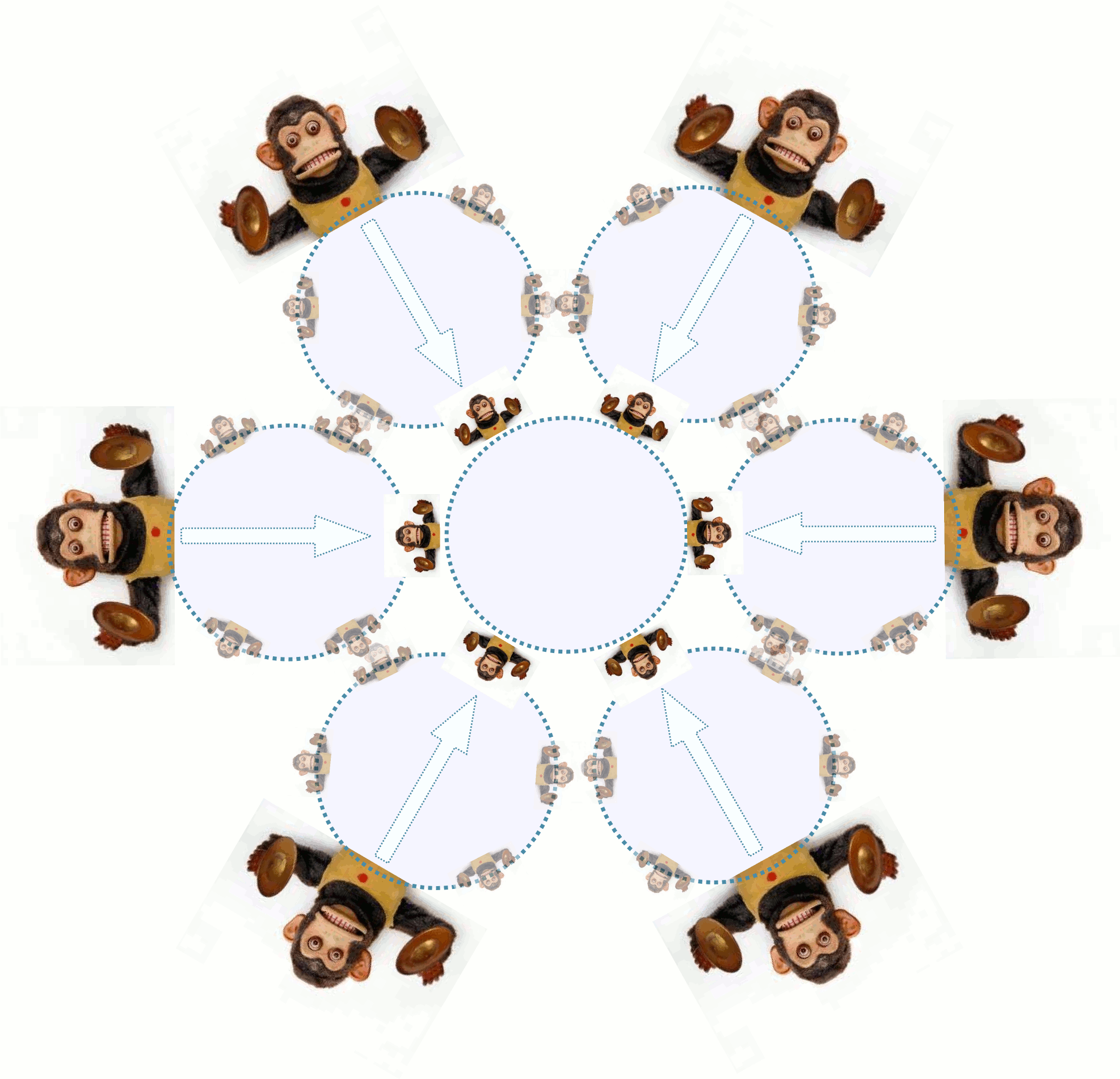
Aggression / conflict brings individuals together… after the conflict!
Also check the comments on my previous post on Methods of conflict management, related to the statement above.
2) Empathy and cooperation
There is an emotional channel, with emotional contagion
There is a cognitive channel, with self-other distinction
No comment to that. It reminds me of Leary’s Rose in a way… Check this older post about loyalty and disbehavior.
When a mouse sees another -familiar- mouse in pain, it bothers that mouse too.
In other words: empathy is not only a behavioral aspect of higher primates. Source: Langford DJ 2006
Getting attention raises the willingness to sharing
Pressuring reduces the willingness to sharing
Nothing new here, although in conflict individuals easily go from excitement to dominance to aggression. At least in the case of dogs, according to Dog Wisperer Cesar Milan… 😉
Unequal rewards induce (emotional) resistance.
Exactlty like Sarah Brosnan (Georgia State University) concludes. The final statement about language -in this video below- is somehow questionable, don’t you agree?